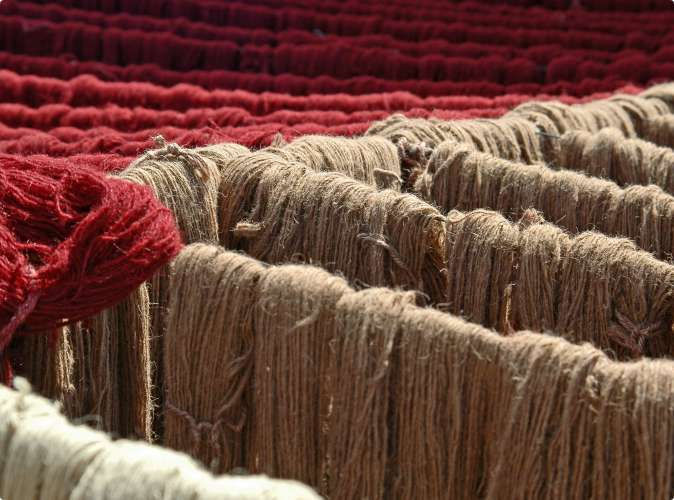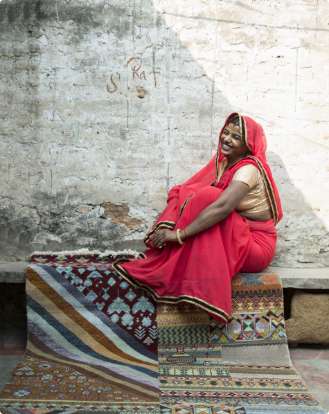Tying the Knot
- Sumana Mukherjee
- 6 days ago
- 4 min read

There's a peculiar emptiness to new homes. The walls are unmarked, the floors echo, and everything still smells faintly of paint and promise. Newlyweds walk through these spaces imagining futures—where the dining table might go, which corner gets morning light, how this room or that will eventually fill with the accumulated evidence of shared life. But in those early days, the space often feels provisional, like a stage set waiting for the actual living to begin.
Jaipur Rugs' Manchaha collection understands that what transforms a house into a home isn't just furniture placement or décor choices, but the presence of things that carry human intention within them. Each creation in the Manchaha collection represents the artistic vision of the artisan(s) involved, given complete freedom to create from imagination rather than instruction.

The word "Manchaha" itself comes from Hindi, popular within India's weaving communities, and translates roughly as "expression of my heart." It's an appropriate name for a collection that inverts the usual hierarchy of rug production. Typically, designers conceive patterns and weavers execute them—their skill valued but their creativity constrained by predetermined designs. Manchaha removes those constraints entirely, positioning artisans as the architects of their own artistic expressions, allowing their creativity to flow through the knots freely.

The results are impossible to predict or replicate. Manisha's "Leheriya Ki Kalpana" in wool and bamboo silk captures something of traditional leheriya dyeing patterns but filtered through her particular sensibility. Sumitra's "Aandhi" evokes wind and movement. Rajjo's "Safarnama" and Suman’s Kufri become journeys rendered in knots and colour.
Manju Devi from Dhanota village created "Aas Paas," drawing inspiration directly from her immediate surroundings—her chulha (traditional stove), the painted walls of village homes, the patterns formed by cow dung that covers floors and walls in rural Indian architecture. This rug won four international design awards, proving that artistic authenticity needs no translation, that the specific details of one woman's daily life in rural India can resonate across cultures and contexts.

The technical aspects matter too. These are hand-knotted rugs, requiring the piece to pass through 180 hands from start to finish—90 people, each possessing unique and irreplaceable skills that take years to develop. This level of human involvement is increasingly rare in manufactured goods. Most objects in contemporary homes are made by machines or assembly processes where individual workers contribute identical repeated actions. Hand-knotting a rug demands sustained attention, technical mastery, and creative interpretation at every stage. Originally, the rhythmic practice was guided by the artisans' memory and song, a technique known as Boli weaving, where they would chant the colours for each line of knots.

The creation of a hand-knotted rug begins long before any weaving occurs, with a decentralized network of specialists whose work must be coordinated through what Jaipur Rugs describes as "bridges of compassion, empathy and love." Raw wool is purchased at bi-annual auctions in Bikaner and segregated by hand, supplemented by the finest Merino wool brought in all the way from New Zealand and the silk from China.

Once sorted and washed, this handpicked wool moves to the Katwaris—spinners who transform it through Carding, a process where they place dollops of wool on bristle pads and brush them with another, removing clumped dirt and knots while giving the wool uniformity. The intertwined fibers create a wave-like pattern of thick and thin that stick together to form remarkably durable and textured yarn—over 3,000 of these specialized artisans work within Jaipur Rugs' family.

The yarn then moves to dyeing, using eco-friendly GOTS-certified colors sourced from Colourtex and Huntsman, with a palette exceeding 3,000 shades that can be customized. Each batch of yarn carries inherent color variations that bring character to the finished rug, creating what's known as Abrash or Antique effects as the wool ages and the raw materials interact.

After the weaving itself—which employs various techniques that determine the rug's quality, design, price, and durability—comes eighteen finishing steps that, when done entirely by hand, can take up to a month to complete before the rug achieves its final perfection.
The Manchaha collection was conceptualized by Kavita Chaudhary, Design Director at Jaipur Rugs, as both a sustainability initiative and a way to empower artisans by nurturing their creative talents. The initiative has won eight prestigious global design awards, competing successfully against major design houses and respected companies worldwide. But the real achievement is in the shift in how artisan creativity is valued and utilized within an industrial craft tradition.
Indian heritage craftsmanship often gets relegated to "traditional" or "ethnic" design categories, as if it exists outside contemporary aesthetic conversation. Manchaha demonstrates otherwise: these rugs work in minimalist modern spaces, in maximalist layered interiors, in homes that don't otherwise reference South Asian design traditions. The handwork and creativity transcend style categories, speaking a more fundamental language about quality, attention, and human capability.
Years from now, when your first home has evolved into something else—perhaps outgrown, perhaps transformed by the addition of children or career changes or any of the countless ways life shifts—the Manchaha rug you chose together will still be there, likely in better condition than when you bought it. The rug will have absorbed the living that happened around and on it, becoming part of your domestic history in ways that new purchases never quite manage.
For newlyweds, you are choosing to begin your shared domestic life with objects that embody values worth building around. The rug becomes a daily reminder that beauty and function can coexist with ethics, that the things we surround ourselves with can either contribute to or extract from the larger world. These then transform from abstract principles to literally woven into the fabric underfoot.
That seems like the right note on which to begin.
Support our work on documenting Indian textile heritage—Buy our previous editions!














Comments